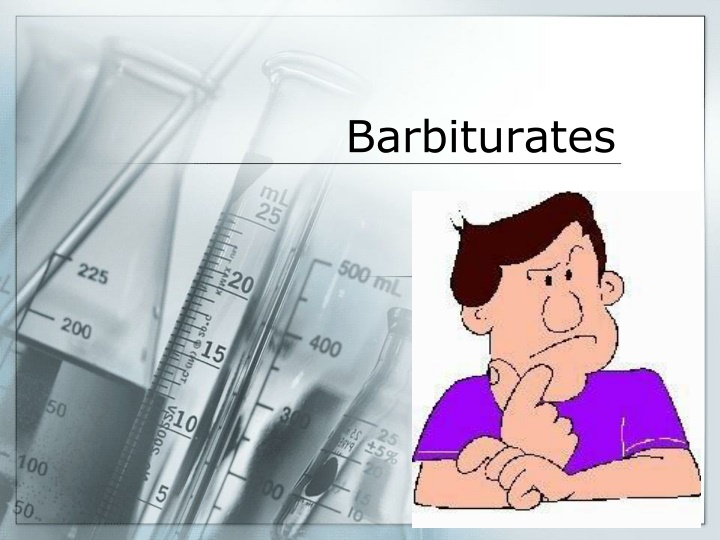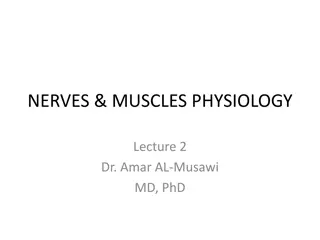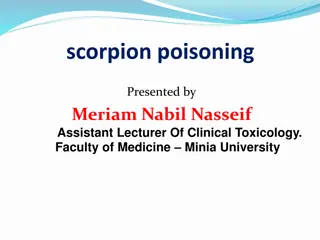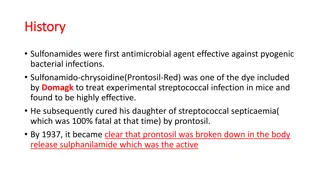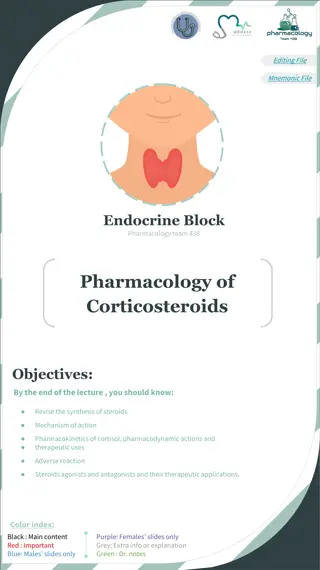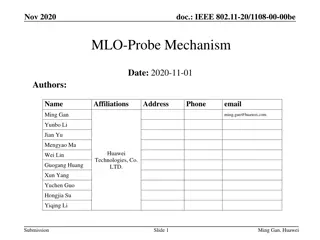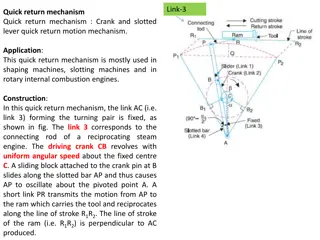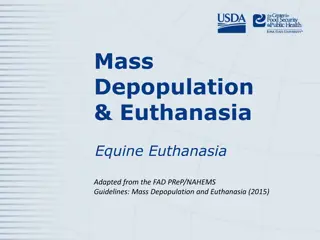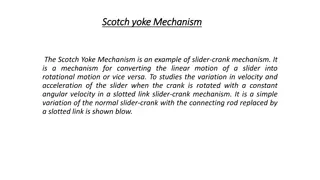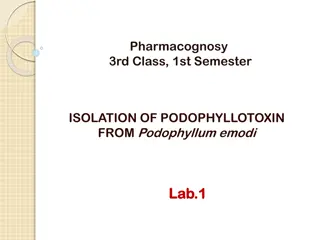Barbiturates: History, Types, and Mechanism of Action
Barbiturates are derivatives of barbituric acid, acting as depressants on the central nervous system by potentiating GABA. First synthesized in 1864, they have a rich history in medicine. Types include Amobarbital, Phenobarbital, and Pentobarbital. The synthesis of barbituric acid involves a condensation reaction of malonic acid and urea. Mechanistically, barbiturates enhance GABA's effect at the GABA-A receptor, leading to CNS depression. They also block the AMPA receptor, prolonging the inhibitory effects.
Download Presentation

Please find below an Image/Link to download the presentation.
The content on the website is provided AS IS for your information and personal use only. It may not be sold, licensed, or shared on other websites without obtaining consent from the author.If you encounter any issues during the download, it is possible that the publisher has removed the file from their server.
You are allowed to download the files provided on this website for personal or commercial use, subject to the condition that they are used lawfully. All files are the property of their respective owners.
The content on the website is provided AS IS for your information and personal use only. It may not be sold, licensed, or shared on other websites without obtaining consent from the author.
E N D
Presentation Transcript
Barbiturates Derivatives of Barbituric acid or Malonylurea: Combination of urea and malonic caid Depressants of the central nervous system, impair or reduce activity of the brain by acting as a Gamma Amino Butyric Acid (GABA) potentiators Produce alcohol like symptoms such as ataxia (impaired motor control), dizziness and slow breathing and heart rate
History Barbituric acid was first preraed in 1864 by a German scientist -Adolf von Baeyer - by combining urea from animals and malonic acid from apples Its first derivative utilized as a medicine was used to put dogs to sleep, latter Bayer produced Veronal in 1903 to be used as a sleeping aid Soon after, phenobarbital and many other barbituric acid derivatives were discovered and marketed
Types BarbituricAcid Amobarbital Phenobarbital Pentobarbital
Synthesis MalonicAcid Urea BarbituricAcid Barbituric acid is synthesized by a condensation reaction that results in the release of H2O (dehydration) and the heterocyclic pyrimidine Further substitution of side chains on the ring produces the pharmacologically active barbiturates
Mechanism of Action Barbiturates potentiate the effect of GABA at the GABA-A receptor. The GABA-A receptor is a ligand gated ion channel membrane receptor that allows for the flow of Cl through the membrane in neurons. GABA is the principle neurotransmitter for this receptor which upon binding causes the channel to open and creates a negative charge in the transmembrane potential. This makes it an Inhibitory neurotransmitter GABA binding site Barbiturate binding site GABA
Mechanism of Action Barbiturates potentiate the effect of GABA by binding to the GABA-A receptor at a nearby site and increasing the chloride flow through the channel. Barbiturates also block the AMPA (2-amino-3-(5-methyl-3-oxo- 1,2- oxazol-4-yl) propanoic acid) receptor which is sensitive to glutamate, the excitatory neurotransmitter. Glutamate performs the opposite effect from GABA restricting ion flow and increasing the transmembrane action potential of the neuron. By blocking this action Barbiturates serve to increase the duration of the receptor response to GABA and extend the depressed condition of the cell.
Uses Barbiturates have been use in the past to treat a variety of symptoms from insomnia and dementia to neonatal jaundice They have largely been replaced with drugs such as benzodiazepine due to their propensity for addiction and reduced effect over the extended use Still used widely to treat seizures particularily neonatal seizures Used when benzo class drugs fail Cannot be used for treatment of absence seizures
Structure activity relationship Modifying the structure of the hypnotically inactive barbituric acid can convert it into a hypnotic barbiturate with physicochemical properties that affect its ability to gain access to its sites of action and to interact with its receptor. Hypnotic activity is introduced into the barbituric acid by the addition of side chains, especially if at least one of them is branched, in positions 5.
Quaternary carbon at position 5 is necessary for activity Unsubstituted compound is more acidic than di-substituted derivatives and do not depress CNS- unionized drug can penetrate the membrane Introduction of one alkyl or aryl group at position 5 has little effect on acidity, whereas two groups decrease the acidity When the sum of C-atoms at position 5 is larger than 7 or 8 activity drops for example dibenzyl barbituric acid produces no effect Introduction of a polar functional group such as ether, keto, hydroxyl, amino and carboxyl, on the side chain usually destroys the depressant effect
contnd The length of the side chains in the 5 position influences both the potency and the duration of action of the barbituric acid derivatives; secobarbital and thiamylal are slightly more potent than pentobarbital and thiopental, respectively, because the former drugs have slightly longer (three-carbon versus two-carbon) side chains in position 5
Replacing the oxygen atom with a sulfur atom at position 2 of an active barbiturate produces a barbiturate with a more rapid onset and a shorter duration of action; the thiobarbiturates, thiopental and thiamylal, have faster onsets and shorter durations of action than their oxybarbiturate analogues, pentobarbital and secobarbital.
Methylation of an active barbiturate in position 1 produces a drug such as methohexital with not only a rapid onset and short duration of action but also an increased incidence of excitatory side effects. Therefore, any chemical modification that increases the lipophilicity of a hypnotic barbiturate generally increases both its potency and its rate of onset while shortening its duration of action.
Many barbiturates have asymmetric carbon atoms in one of the side chains attached to carbon 5 of the barbiturate ring. d isomers are two times potent, despite their similar access to the central nervous system. Differences in the potency of stereoisomers suggests interaction with the chiral active center of a receptor rather than a nonspecific action
Metabolism Metabolic transformation of barbiturates influence the duration and intensity of their action Diethyl barbiturate is excreted unchanged in the urine Most of the other barbiturates are metabolized in the liver before excretion N-methyl barbiturates are demthylated in the liver The terminal carbon of the side chain at position 5 is oxidized into carboxylic acids
Aldehyde derivative-Paraldehyde Aliphatic aldehydes are thought to exert their hypnotic effect by being converted into corresponding alcohols It is trimer of acetaldehyde and is considered to be cyclic acetal of the parent compound It is a safe hypnotic and has prompt action The main disadvantage is its pungent odour, taste and irritating effect on mucosa
Chloral hydrate (trichloroacetaldehyde) A crystalline water soluble hydrate Its active metabolite is trichloroethanol It relieves insomnas without any after effects. However, it causes it causes gastric irritation, cardiac and respiratory depression Trichloroethanol is excreted in urine as its glucuronide
SAR Prolonged use of chloral hydrate leads to a condition similar to alcoholism or morphinism. To lessen its side effects, some derivatives have been produced without side effects. For example trichloroethyl phosphate, which is a satisfactory and safe compound
Chloral betaine It is an aduct of betaine and carboxymethyl trimethyl ammonium It is inert, tasteless and odorless compound Action similar to chloral hydrate (CH3)3N+ CH2 CO2-
Petrichloral It is a hemi-acetal fromed from chloral hydrate and penta erythrol Has similar properties to chloral hydrate but free from after taste and GI irritation
Alcohols Ethyl alcohol Is narcotic and depresses, first the highest cerebral center and then the lower ones, cerebellum and spinal chord Hypnotic activity increases with the increase in molecular weight, maximum with n-hexanol or n-octanol, afterwards activity declines Branching in alkyl chain raises the activity, primary< secondary <tertiary Chlorination or bromination of simple and branched alcohol induces favorabl effect on distribution coefficient. For example trichloro or tribromoethanol has strong hypnotic activity
Chlorobutanol 2 hydroxy, 2 methyl, 1,1,1 trichloropropane (trichloro-2- methyl-2-propanol) It is a strong hypnotic agent and has been used as preanesthetic medication It is as dangerous as chloral hydrate
Methyl parafynol Has pronounced hypnotic effect with wide margin of safety Active orally and parenterally Short duration of action due to oxidation of triple bond
Ethchlorvynol A sedative and hypnotic agent developed by Pfizer in the 1950. It was used to treat insomnia, but had largely been superseded Still offered where an intolerance or allergy to other drugs exist Along with expected sedative effects, ethchlorvynol can cause skin rashes, faintness, restlessness and euphoria. An overdose is marked by confusion, fever, peripheral numbness and weakness, reduced coordination and muscle control, slurred speech, and reduced heartbeat.
Synthesis By the reaction of lithium acetylide with 1-chloro-1- penten-3-one in liquid ammonia
Ethinamate is a short-acting carbamate-derivative sedative-hypnotic medication used to treat insomnia. Regular use leads to drug tolerance, and it is usually not effective for more than 7 days. Prolonged use can lead to dependency. Synthesized by combining acetylene with cyclohexanone and the transformation of the resulting carbinol into carbamate by the subsequent reaction with phosgene, and later with ammonia.
Glutarimide derivatives Glutarimide is a chemical compound featuring a piperidine ring with two ketones attached next to the nitrogen Glutethimide Structurally similar to phenobarbital and produce hypnotic effect similar to barbiturates Has short duration of action Side effects include skin rash, nausea and addiction. Administered orally-500mg
